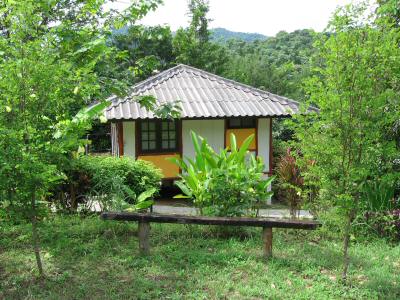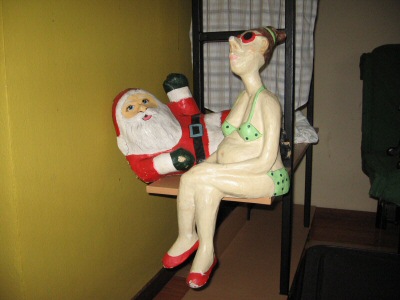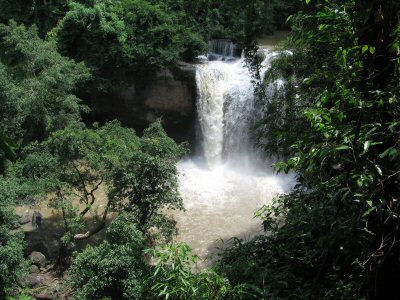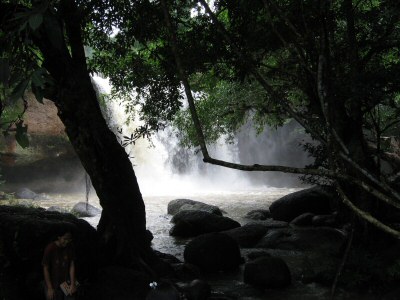Krabi, a province in the south of Thailand, is on the Andaman cost, an area famed for its beautiful sandy bays and a magnet for both foreign and domestic tourists alike. One of the most stunning parts is the Railay peninsula where the beaches are backed by towering limestone cliffs. There the beaches and the resorts that line them are accessible only by boat, so, after a late afternoon flight from Suvarnabhumi I found myself on a wooden boat crossing the open sea in the dark, guided only by the lights of distant villages.
The boat grounded itself on the gently sloping sands of Railway West, some metres offshore. A tractor then hauled a trailer next to the boat onto which my luggage was loaded and I leapt. The tractor then mounted the beach and a stepped ashore, feet still dry.
The resort I stayed in was nothing to write home about – not that that will stop me here. The bungalows were fairly basic, little more than an aircon’d box with bed and TV with an attached wetroom. The shower was feeble and everything a little chipped and faded. Still, it was clean and perfectly adequate.
Daylight unveiled the cliffs in their full awesomeness

and in their fantastical detail.

It also revealed the tiny islands that dot the bays.
There’s not a lot to do here – just a handful of minor attractions. One is Phra Nang’s cave, named after a legendary princess whose spirit inhabits this place. She has an interest in curiously-shaped wooden offerings.

Local fishermen, both Moslem and Buddhist come here to leave their carved oblations. Similarly shaped rocks attract similar attentions.

Another attraction is a pool on top of one of the cliffs. To get here one climbs almost vertically up a craggy slope, making toeholds of exposed roots and hauling oneself up on strategically-placed knotted ropes. (Yes, that improbable scrabble is the foot of the path on the left.)

300 metres or so later – vertically – one reaches the top where a path to the right leads towards the pool. A similar vertical descent becomes increasingly treacherously slippery with mud. Eventually one gets a view of the pool through a cleft in the rock. (Really not worth the effort – hence no photo.) The pool itself, so it seems, would only be accessible with mountaineering equipment.
I hauled myself back up to the top and followed a path which led to a viewpoint from which one could see the Railay peninsula and the bays on both sides.

The climb down was almost as arduous as the ascent. However, I made it with all limbs and skull intact. Frankly, this was one of the more foolhardy things I’ve done in my life.
***
A morning walk on the beach showed the place to be alive with thousands of tiny crabs – no lager than a fingernail. As one approached they scuttled for the nearest hole in the sand. The occasional crab, unable to find a vacant hole, would hare off at great speed, sideways, of course, ultimately to take refuge in the sea.
A less vibrant creature on the foreshore was this dead puffer fish.

Crab, along with other seafood – features prominently in the menus of the local restaurants, all of which seem to offer the same range of central Thai dishes and farang favourites (burger & chips, pizza or English fish & chips, anyone?) – all of which are prepared to the same miserably low standard. Doubtless the backpacker crowd and package tourists think they are eating authentic Thai food, and no less doubtless consider it both exotic and delicious. I found it simply incompetent and showing utter contempt for the clientèle.
One day I took a trip back to the “mainland”. Here there are distinct areas for farangs, with their bars, pizzerias, Indian restaurants and places all claiming (fraudulently, I’m sure) to serve the best, authentic Thai food. The Thai areas have large, swanky resorts and simple restaurants. I had lunch at one such place that had been recommended. From the outside it looks like a tiny shop, but beyond is a massive restaurant with trays of various sea foods on ice. This being lunchtime there was only a handful of customers, and service was prompt. I greatly enjoyed clams stir-fried with green peppercorns, garlic and soy sauce, small conchs steamed with lemon grass, and a very spicy sour orange curry (more like a soup, really) with slices of coconut shoots and slabs of fish. It’s in a totally different league from the food available in the areas catering for foreigners.
It was in the restaurant that I saw one of only two signs that this whole area had been devastated by the Asian tsunami on Boxing Day, 2004; here were photos on the wall showing the wreckage of the restaurant’s former incarnation.
The other sign was a memorial, with a small, touching sculpture by Louise Bourgeois of a pair of praying hands in the embrace of a similar pair of hands, arising out of a turbulent sea.

It’s entitled “Hold Me Close”.
Requiescant in Pace.
***

[361]








































Recent Comments